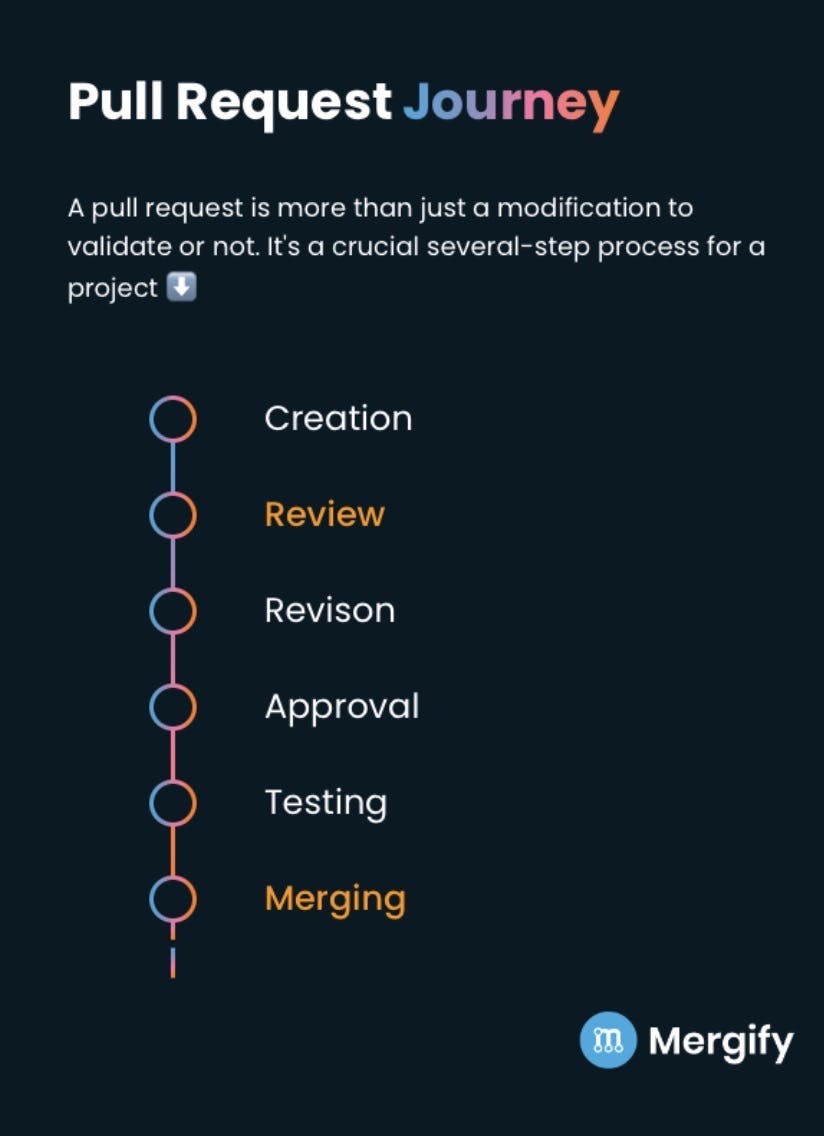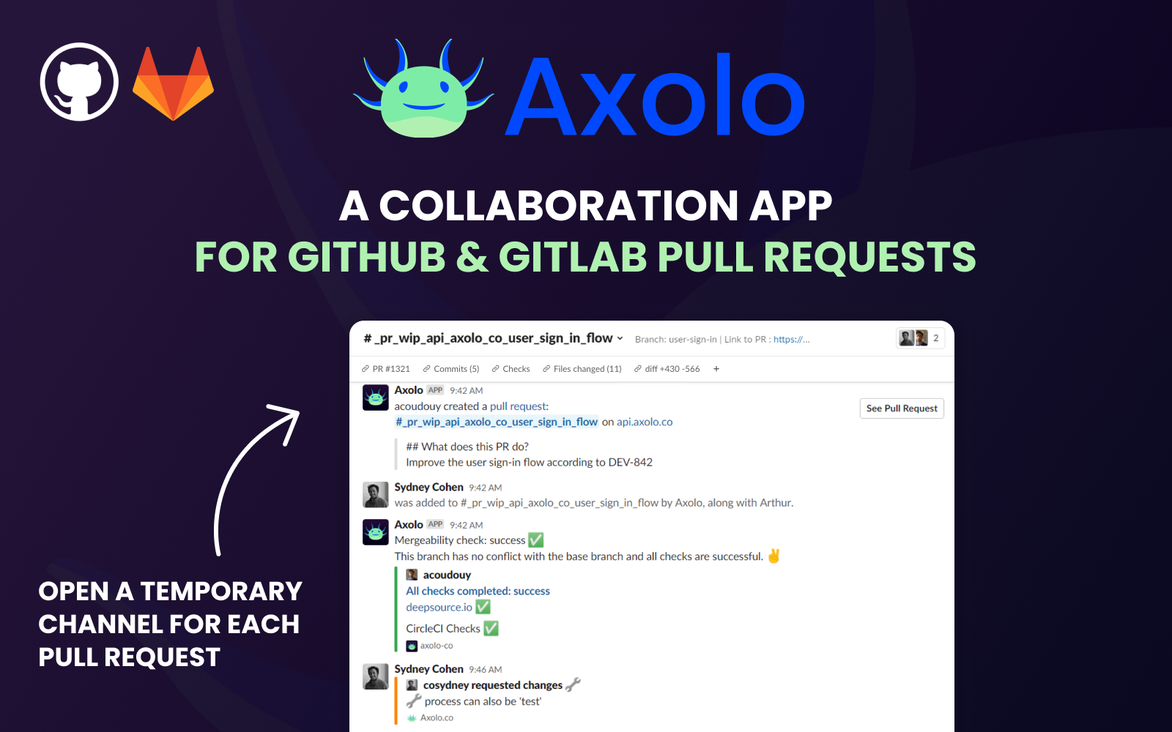- Published on Tuesday, October 3, 2023, last updated
Streamline Your Pull Request Journey With a Merge Queue
Table of Contents
Did you know? Pull requests were introduced on February 23rd, 2008, through ! Imagine being the first person ever to ask, 'Hey, can you check my code?' on such a platform. Do you remember your first one?
Pull requests are a cornerstone of collaborative software development for many reasons. They foster collaboration, ensure code quality, and maintain a documented history of changes, making them essential for successful software development.

Some steps can be longer than others. For instance, the time taken for a pull request to merge can range from a few hours to days. The entire life cycle of a PR—from its creation to merge—often averages between one to two weeks. That's why, akin to mastering any art form, understanding and adopting best practices in PR management is crucial.
1. PR Journey: A Life Full of Obstacles
Embarking on the journey of a pull request, each phase holds its significance and requires meticulous attention. Just as performance is more than its individual acts, a pull request is more than just code—it's collaboration, feedback, and co-construction.
While it might seem linear, during the whole process, many actors will enter the game, increasing the chances to face issues, making challenges arise like:
Delayed Reviews due to:
- Fragmented Communication: It's easy for team members to lose track of project updates and messages.
- Ambiguous Feedback: Vague comments can lead to misunderstandings, requiring further clarification.
- Context Switching: Constantly shifting between tasks like coding and reviewing can disrupt focus.
Merge conflicts due to:
- Manual Merges: Merging multiple PRs that modify the same code sections can be error-prone.
- Repository Maintenance: For active projects, the sheer volume of pull requests can become overwhelming.
- Dependency Issues: New or updated dependencies can introduce compatibility or security concerns.
Addressing these challenges often requires a combination of best practices, clear communication, training, and the right tooling. That’s what we will discuss now.
2. Best Practices
The pull request process, foundational to collaborative software development, holds significant stakes. It affects not just the speed, but the very quality and reliability of the code that gets shipped. As such, mastering the intricacies of PRs is paramount. To streamline it, consider these best practices:
- Promote Clear Communication: The importance of clarity can't be overstated. Encourage contributors to provide detailed PR descriptions, use clear commit messages, and document any changes. This approach makes it easier for reviewers to understand the context and intent.
- Limit PR Size: Encourage developers to make PRs small and focused. Smaller PRs are easier to review, understand, and test. Consider implementing a guideline that suggests breaking down larger tasks into multiple smaller PRs.
- Adopt Automation: Utilize tools that automate tasks like code reviewing, merging, and testing. This not only speeds up the process but also minimizes human errors. CI systems can run tests automatically, ensuring that every PR meets the quality benchmarks.
- Standardize Code Practices: Establish and enforce coding rules across the team. Utilizing code formatters and linters can help maintain consistency and quality, reducing nit-picking during reviews.
- Manage Dependencies Proactively: Implement tools to automatically check and update dependencies. Regularly updating dependencies can prevent compatibility issues and bolster security.
3. Tools to Facilitate the PR Process
In the vast realm of software development, certain tools have emerged as game-changers, especially when it comes to simplifying the pull request process:
Axolo: Transforming PR Reviews with Slack-Centric Workflows
Axolo revolutionizes the pull request (PR) review process by offering a Slack-integrated experience that's not only collaborative but also highly efficient. Here's how Axolo enriches your PR management:

1 PR, 1 Channel: Streamlined Reviews: Axolo adopts a '1 PR, 1 Channel' methodology, creating a dedicated Slack channel for each GitHub or GitLab pull request. This channel invites the PR author and reviewers, keeping them updated with real-time notifications on code comments, GitHub Actions, Deployments, PR checks, or GitLab CI/CD. Once the PR is closed or merged, the channel is archived, ensuring a clutter-free workspace.
Two-Way Sync: GitHub/GitLab and Slack: Say goodbye to constant tab-switching. Axolo offers a two-way sync between your GitHub or GitLab and Slack, allowing for contextual and efficient discussions right within your Slack channels.
Comprehensive Team Management Tools: Axolo goes beyond just PR management by offering a suite of tools designed to keep your team on track. From daily pull request reminders to organizing stand-ups and setting code review timeslots, Axolo ensures that your team is always in sync and productive.
Axolo is a Slack app to help techteams review pull request seamlessly
Axolo User Experiences
2480+ developers online

Mergify
Mergify is not just another automation tool; it's tailored for GitHub’s PR management, with many possibilities:
- Automated Merging: Depending on predefined criteria, such as successful CI tests or the number of approvals, Mergify can automatically merge PRs.
- Merge Queue: It can queue PRs to be merged in a specific order, and more with specific features.
- Workflow Automation: Through its rule system, you can define conditions under which certain actions are taken, offering flexibility and control.
- Dashboard Integration: With the Mergify dashboard's seamless integration with GitHub, developers and teams can monitor and manage PRs effectively, providing a consolidated view of pending and completed requests.
Incorporating tools like Mergify and Axolo into your PR process doesn't just automate tasks; it elevates the entire workflow. The collaboration becomes more streamlined, dependencies are managed efficiently, and the chances of manual errors significantly reduced.
4. The power of automation: Use Case
Imagine Croissant, a tech company navigating the challenges of an ambitious project. With their global team, they often grapple with prolonged review times, ambiguous feedback, manual merges, and outdated dependencies. Here's how integrating Mergify and Axolo can transform their PR process:
1. PR Creation Phase:
Hugo, a Croissant developer, completes a new feature and initiates a PR. Axolo springs into action, sending an immediate notification on a dedicated Slack channel during the timeslot Croissant set up previously to review PRs. This visibility prompts swift reviews.
2. Review Phase:
Reviewers dive into Hugo’s code. Any feedback or queries are relayed on Slack, and pushed directly on GitHub as PR comments, thanks to Axolo. Hugo is promptly notified of each comment, enabling him to address issues or provide clarifications seamlessly.
3. Automated Merging with Mergify:
Instead of waiting for manual reviews of dependency updates (which can be frequent and minor), Croissant has set rules in Mergify to automatically review and merge these updates. If Dependabot's PR meets the specified criteria, such as passing automated tests, Mergify merges it without manual intervention. This ensures that Croissant’s codebase remains updated and secure without inundating the team with minor reviews, Axolo helping them to focus on reviews that matter.
4. Final Merging Phase:
- With all reviews done and dependencies updated, it's time to finalize Hugo’s PR.
- Mergify, with its set rules, verifies if Hugo’s PR fulfills all conditions, such as required approvals and successful test results. On meeting these, Mergify automatically merges the PR, making the process efficient and error-free.
- Axolo archives the pull request channel as a result, letting developers know that this
Through the combined prowess of Axolo and Mergify, Croissant manages to foster a PR process that's not only faster but also ensures higher code quality and security.

Making a Merge Queue work for you
By now, you've navigated the complexities and nuances of pull requests, recognized the pitfalls that can slow down the PR process, and explored a selection of best practices and tools designed to make your life easier. You've even seen how companies like Croissant utilize tools like Axolo and Mergify to maintain a high level of code quality and security while speeding up their review and merge times.
However, understanding is only half the battle. The key to a streamlined PR journey lies in action, and there's no better place to start than implementing a Merge Queue in your workflow.
Here are your actionable steps:
Audit Your Current Process: Identify bottlenecks and pain points in your existing PR process that can benefit from a Merge Queue.
Assemble Your Toolkit: Evaluate tools like Axolo for real-time PR notifications and Mergify for automated merging. Choose those that align with your team's needs and integrate them into your existing systems.
Standardize Practices: Ensure your team is on the same page regarding code review standards, PR sizes, and communication protocols. The right Merge Queue can help enforce these practices.
Automate: Deploy automation for code reviews, dependency checks, and merging wherever possible to minimize human error and speed up the PR lifecycle.
Measure and Iterate: After implementation, monitor key metrics such as time-to-merge, review efficiency, and code quality. Use this data to refine your approach and make necessary adjustments.
By making a Merge Queue work for you, you're not just optimizing a single aspect of software development but elevating your entire workflow.